What do you mean by Total Internal Reflection?
- The inside surface of water can act like a perfect mirror as shown in Figure.
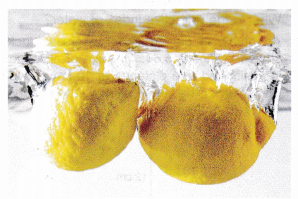
- This happens when the light rays strike the surface of the water in such a way that it reflects back into the water.
- The light rays are said to be reflected internally. This phenomenon is known as total internal reflection.
- It occurs only when light travels from a denser medium to a less dense medium and the angle of incidence is greater than a certain angle.
- Definition: When light travels from a denser medium to a rarer medium and is incident at an angle more than the critical angle for that medium, it is completely returned inwardly in the denser medium. This complete inward return of light is called total (complete) internal (inward) reflection (return).
Which condition is necessary for total internal reflection?
- Light must travel from denser to rarer medium.
- Light must be incident at an angle more than the critical angle for the denser medium.
Merit: In total internal reflection 100% light is reflected, hence images formed are more bright.
In ordinary reflection from mirrors, only 85% light is reflected, rest 15% is either absorbed by mirror glass or transmitted due to poor polish. Images formed by ordinary reflection are less bright.
People also ask
- Why does total internal reflection take place in optical Fibre?
- Analysing Reflection of Waves
- Applications of Total Internal Reflection
- What is Reflection of Light?
- Application of Reflection of Light in Daily Life
- What is the Law of Reflection of Light?
- Image Reflection by a Plane Mirror
- Which Type of Image is Formed by a Plane Mirror?
- Is an Image formed by Reflection Real or Virtual
- Reflection of Light from Spherical Mirror
- What are Concave and Convex Mirrors?
- How is Focal Length related to Radius of Curvature?
- How is the Image Formed by a Spherical Mirror?
Total Internal Reflection and Critical Angle
- An interesting phenomenon occurs when light travels from a denser medium to a less dense medium, such as when light goes from water into air as shown in Figure.
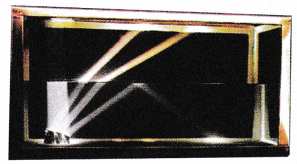
- In such a case, a light ray will bend away from the normal. The angle of refraction is larger than the angle of incidence. A small part of the incident ray is reflected inside the water.
- When the angle of incidence increases, the angle of refraction also increases. However, as the angle of refraction becomes larger, it will reach 90° before the angle of incidence does. At this instance, the refracted ray will be moving along the boundary between the two media.
- This is the limit of which the light ray can be refracted as any larger angle will mean that the light ray will travel back into the medium it came from.
- The angle of incidence at this limit is called the critical angle, c of the medium.
- Critical angle, c is defined as the angle of incidence in the denser medium when the angle of refraction, r in the less dense medium is 90°.

- If the angle of incidence, i is increased further so that it is greater than the critical angle, c (i > c),
the light is no longer refracted but is reflected internally and will obey the laws of reflection. This condition is called total internal reflection. The whole process can be summarised as shown in Figure. - The two conditions for total internal reflection to occur are:
(a) The light ray must travel from a denser medium to a less dense medium.
(b) The angle of incidence, i must be greater than the critical angle, c of the medium.
Derive a Relationship between Critical Angle and Refractive Index of a Substance
- Figure shows that when a light ray is incident at the water-air boundary at the critical angle, c, it is refracted at 90° to the normal.

- The refractive index of water is given as:

- Applying the principle of reversibility of light, the light ray is reversed and follows the same pathway as shown in Figure.
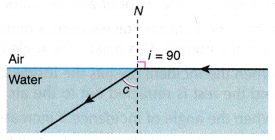
- Hence, the refractive index of water:
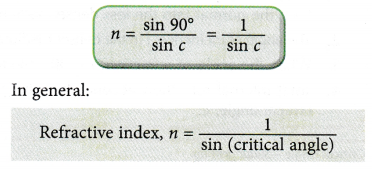
Total Internal Reflection Examples
Natural Phenomena Involving Total Internal Reflection
Mirages
- When travelling in a car on a hot and sunny day, a person sees a pool of water appearing on the road ahead that disappears as the car approaches it. What the person is actually seeing is a reflection of the sky above.
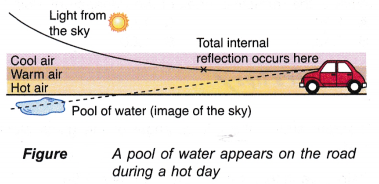
- This happens when light passes through layers of air with different temperatures. The sun heats the road, which in turn heats the air just above it. The layers of air near the ground are hotter and less dense. The layers of air higher up are cooler and denser.
- The refractive index of air depends on its density. The lower or hotter layers have a lower refractive index than the layers above.
- Light from the sky is refracted gradually towards the horizontal after passing through the different layers of air of different densities.
- Eventually, it meets a layer of air near the ground at an angle greater than the critical angle. Total internal reflection takes place and the light is reflected upwards.
- If the person’s eye is in the correct position, he or she will see a pool of water (image of the sky) appearing on the surface of the road. This is known as a mirage.
Rainbow
- A rainbow is formed by refraction, dispersion and total internal reflection of light within water droplets.
- When sunlight shines on millions of water droplets in the air during and after rain, we see a multicoloured arc. The colours run from violet along the lower part of the arc to red along the upper part of the arc.
- The light that forms the primary rainbow is first refracted and dispersed in the water droplet. Then, the light is reflected once inside each water droplet. Finally, the light is refracted and dispersed again upon exiting the water droplet. This results in the light being spread out into a spectrum of colours, as shown in Figure.

- We see the rainbow only as an arc because its formation by water droplets is cut off at the ground as shown in Figure.
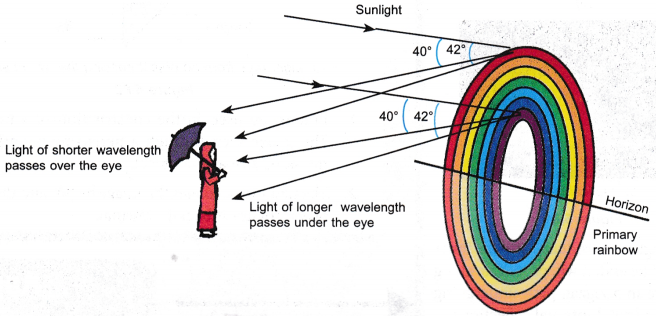
Total Internal Reflection Example Problems with Solutions
- (a) A glass block has a refractive index of 1.52. Calculate the critical angle, c for glass.
(b) The critical angle for water is 49°, determine the refractive index of water.
Solution:
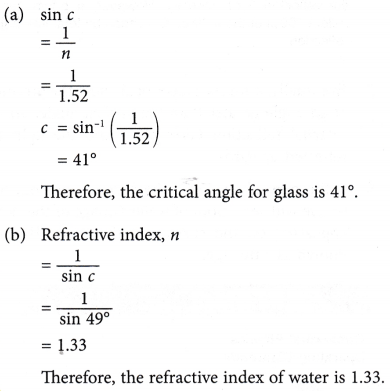
- Figure shows a light ray travelling from air into a glass prism.
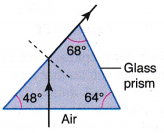
Determine the refractive index of the glass prism.
Solution:
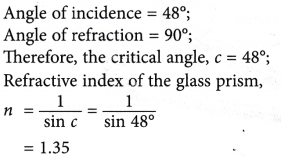
- Diagram shows a light ray propagated in a semi circular glass block.
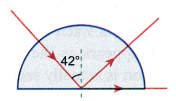
What is the refractive index of the transparent block?
Solution:

- The velocity of light in air is given as 3.0 x 108 ms-1. What is the velocity of light in a clear plastic block of refractive index 1.54?
Solution:
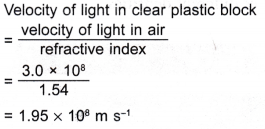
Total Internal Reflection Experiment
Aim: To show the effect of increasing the angle of incidence on the angle of refraction when light travels from a denser medium to a less dense medium.
Material: White paper
Apparatus: A pair of compasses, protractor, semicircular glass block, ray box with single slit.
Method:

- The apparatus is set up as shown in Figure.
- A semicircular glass block is placed on top of a white paper with a circle drawn in degree scale.
- A light ray is directed along AB through the semicircular glass block from its curved edge. The light ray that passes through the glass block is observed.
- The light ray is moved slowly from A to C to increase the angle of incidence, i. The changes in the refracted light ray are observed.
- When the angle of refraction, r reaches 90°, the angle of incidence, i is measured.
- The angle of incidence, i is increased further and what happens to the light ray is observed again.
Discussion:
- When the light ray strikes the glass block along AB, which is the normal, it passes through the glass block in a straight line without any deviation.
- When the light ray travels from a denser medium (glass) to a less dense medium (air), it is refracted away from the normal. This makes the angle of incidence, i in the glass smaller than the angle of refraction, r in air.
- When the incident ray hits the inside surface of the glass block, a part of the ray is reflected inside.the glass and the rest is refracted out to the air.
- When the angle of incidence, i increases gradually, the angle of refraction, r also increases. When the angle of refraction, r reaches 90°, the refracted ray moves along the flat surface of the glass block. At this instance, the angle of incidence, i is known as the critical angle, c of the glass block. The value of the critical angle, c for glass, is 42°.
- When the angle of incidence, i is further increased so that it is greater than the critical angle, c the light ray is no longer refracted. Instead, the light ray is reflected internally.
Conclusions:
- When the angle of incidence, i in a denser medium is less than the critical angle, the ray is refracted away from the normal into the less dense medium.
- The angle of incidence, i in the denser medium is smaller than the angle of refraction, r in the less dense medium.
- When the angle of refraction, r = 90°, the angle of incidence, i is known as the critical angle.
- Total internal reflection occurs when the angle of incidence, i in the denser medium is greater than the critical angle, c.
